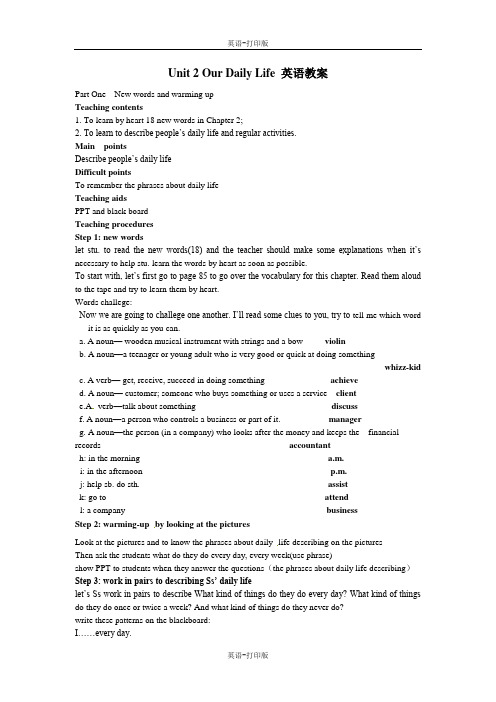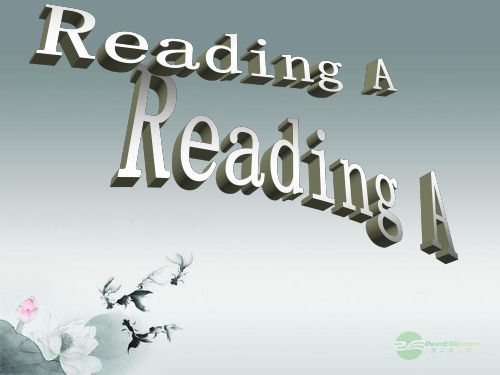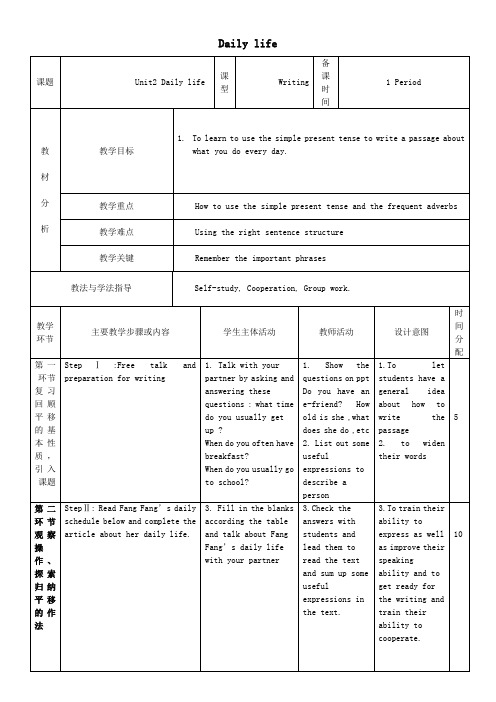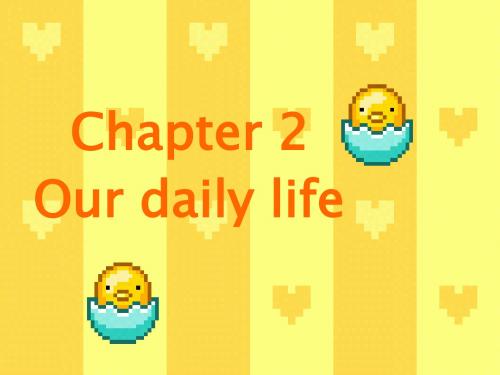英语:牛津深圳版七年级上unit2OurDailyLife(教案)
- 格式:pdf
- 大小:49.80 KB
- 文档页数:7

Unit 2 Our Daily Life 英语教案Part One New words and warming upTeaching contents1. To learn by heart 18 new words in Chapter 2;2. To learn to describe people’s daily life and regular activities.Main pointsDescribe people’s daily lifeDifficult pointsTo remember the phrases about daily lifeTeaching aidsPPT and black boardTeaching proceduresStep 1: new wordslet stu. to read the new words(18) and the teacher should make some explanations when it’s necessary to help stu. learn the words by heart as soon as possible.To start with, let’s first go to page 85 to go over the vocabulary for this chapter. Read them aloud to the tape and try to learn them by heart.Words challege:Now we are going to challege one another. I’ll read some clues to you, try to tell me which word it is as quickly as you can.a. A noun— wooden musical instrument with strings and a bow violinb. A noun—a teenager or young adult who is very good or quick at doing somethingwhizz-kidc. A verb— get, receive, succeed in doing something achieved. A noun— customer; someone who buys something or uses a service cliente.A verb—talk about something discussf. A noun—a person who controls a business or part of it. managerg. A noun—the person (in a company) who looks after the money and keeps the financial records accountanth: in the morning a.m.i: in the afternoon p.m.j: help sb. do sth. assistk: go to attendl: a company businessStep 2: warming-up by looking at the picturesLook at the pictures and to know the phrases about daily life describing on the picturesThen ask the students what do they do every day, every week(use phrase)show PPT to students when they answer the questions(the phrases about daily life describing)Step 3: work in pairs to describing Ss’ daily lifelet’s Ss work in pairs to describe What kind of things do they do every day? What kind of things do they do once or twice a week? And what kind of things do they never do?write these patterns on the blackboard:I……every day.I……once or twice a week. I never ……(Encourage students to speak up their daily activities as many as possible.)e.g. A: What kind of things do you do every day?B: I clean my teeth, wash my face and hands, make a telephone to my parents, watch television, go to school, do my homework every day.A: What kind of things do you never do every day?B: I never play the piano, ride a bike, go to the supermarket, argue with other classmates, come to school late.A: What kind of things do you do once or twice a week?B: I eat fish, play tennis, play computer games, go to the concert, eat chocalates, take a bus once or twice a week.Step 4: Homework1. Preview the Reading in Chapter 2;2. Learn the new words by heart.Part Two Reading (1)Teaching contents:1.How to describe our everyday activities and how often we do things.2.The daily life of a ‘whizz-kid’ studentMain pointsRead the text and abstract the important information from the textDifficult pointsChange the information into chartTeaching aidsmultimedia, tape-recorder, PPTTeaching produceduresStep 1: leading-inAsk the students when they usually get up in the morning, when they go to school and so on . Then lead in the topic of this chapter ‘ Our Daily Life’. And show them some pictures and let them do the ‘ask and answer’ activity.Which of these things do you do every day / do once or twice a week / never do?S tep 2: pre-readingLet students talk about their daily life, and then compare with the life of Wendy (look at the picture).Step 3: while-readinga. Skim the text and use one sentence to abstract the main idea of the text.b. Scan the text and to get the main idea of each paragraph, finish this chartP1 Wendy describes her school. She finds some school work easy but boring.P2 At lunch-time she sometimes has lunc h w ith a business client.P3 Wendy describes her morning routin and the background to her familycomputer business.P4 Wendy’s driver takes her to school in her own car.P5 In the evenings she works on her computer games.P6 Wendy describes her after-school activities.c. Read the text again and find the facts. Turn to page 18 complete the list with information that Wendy gives us in her article. Write only notes (one to three words or figures) for each answer.1. What she writes computer games2. when she gets up 6 a.m.3. How she gets to school 7.30 a.m4. How she gets to school in her car5. What she does on the way makes phone calls6. Her usual grade at school A7.when she goes to Computer Club Friday8.when she has dinner 7 p.m.9.Her work after dinner writing computer games10.when she goes to bed 11 p.m.Step 4: post-readingAsk the students to read the passage again and do the exercises on page 19 in the book.Step five: summary1.how to talk about our regular activities we do every day or every week / month2.what does Wendy do every day?Step 6: homeworkExercise book page 13-14Do a survey of “how often do you…” (see in PPT)Part Three Reading (2)Teaching contentsLanguage points in the textTeachi ng aims and demandsTo find out and analysis the usage of language points (phrases and words)Main points14 phrases and 4 words usagesDifficult pointsPut on/ wear/ have on the difference among them, assist, attendTeaching aidsPPT and black boardTeaching proceduresStep 1: warming-upListen to a s ong: Here I amStep 2: language points learninga.the top studentb.must bec.businessd.put on/wear/have one.have breakfast/lunch/dinnerf.discussg.in my own carh.make a phone calli.on the way toj.enjoy doing sthk.achievel.fail an examm.twice a weekn.attendo.have computer club meetingp.assist sb with sthq.continue to do sth/continue doing sthExpain them one by oneStep 3: HomeworkExercise book page 15;Preview the Language in Chapter 2.Part Four LanguageTeaching contents1. How to use verbs in the simple present tense to talk or write about things happening all the time or a number of times.2. How to use adverbs and adverbial phrases to say how often things happen.Teaching aidsmultimedia, tape-recorder, PPTTeaching produceduresStep 1: leading-inAsk the students what Wendy usually do in his daily life. Then lead in the language of this chapter ‘ the simple present tense’. Give them some sentences of the simple present tense, and ask them to find out the structure of the tense.Step2:1.help them find out the structure of the simple present tense肯定句:主语+am/is/are+其它成分.主语(除第三人称单数)+动词原形+其它成分.否定句:主语+am/is/are not+其它成分.主语(除第三人称单数) +don’t+动词原形+其它成分.一般疑问句:Am/Is/Are+主语+其它成分?Do +主语(除第三人称单数) +动词原形+其它成分?特殊疑问句:疑问词+is/am/are +主语+(其它成分)?疑问词+do +主语+动词原形+(其它成分)?The consistent of simple past tensea. I like fish./he likes fish.I am a student.b. I don’t like swimming./they are not in the library.c. is it a tall tree?/ does the earth go around the sun?d. What time is it now?2. help them to find out the rules of ve rb changea. –sb. s, x, sh, ch, o –esc. constant songs+y -ies3. do some exercisesStep 3:1. read the sentenses in the book and find out the usage of the adverbs and adverbial phrasesFind out the difference of the words:always --- usually --- often --- sometimes --- seldom --- never2. do some exercisesStep 4: consolidationDo exercisesStep 5: summary1.How to use verbs in the simple present tense to talk or write about things happening all thetime or a number of times.2.How to use adverbs and adverbial phrases to say how often things happen.Step 6: homeworkExercise book page 15-16Part Four Listening & SpeakingTeaching contents:Get the students to know some listening skill ( make notes).Get the students to know how to describe a daily life.How to describe our everyday activities and how often we do things.Teaching aidsmultimedia, tape-recorder, PPTTeaching producedures:Step one: Lead in and pre-listeningwhat does your father or mother do every day?Predicting: where, when, whatStep two: while-listening1.play the tape for the first time. Get the students to know the general idea of the listeningmaterial with writing anything.2.students listen for the second time and work out which person is talking. Then check theanswer.3.play the recording again and ask students to complete part B.Step 3: post-listening1.hand out the tapescript and find out the words they listen to.2.read the tapescript.Step 4: speakingAsk the students about the daily life of Wendy, let them use the Yes / No to answer the questions.1. Is Wendy still a student?2. D oes Wendy drive herself to school?3. Does Wendy fail an exam?4. Can Wendy play the violin?5. Does Wendy have breakfast at 7:30 a.m.?6. Does Wendy like her school friends?Step 5: presentation1.Ask the students to pay attention to the teacher’s voices.When we ask a Yes/No question, we make our voices rise at the end. Also we make our voices rise to show politeness.2. ask them to do some practice.Step 6: speak-upWork in pairs to find out about your classmate’s habits. Ask your partner the questions and write down the answers.Step 7: homeworkExercise book page 18-19Part Five WritingTeachi ng contentsHow to write about a person’s daily life.Teaching aidsmultimedia, PPTTeaching produceduresStep 1: leading-inRetell the story of Wendy using the simple present tense.Review what we learnt in chapter 2 and arouse students interest towards the topic.Step 2: discussionGive some key words and ask them how to write them into a correct sentence.1.play basketball, her friend, from 4.00 to 4.30 p.m., at school, once a weekShe plays basketball with her friend from 4.00 to 4.30 p.m. at school once a week.2.live nearby, always walk to school, go to school, 7.45 a.m., usually arrive, 8 a.m.She lives nearby and always walks to school. She goes to school at 7.45 a.m. and usually arrives at 8 a.m.Step 3: write a sentence correctlyExercise in the book on page 27.Step 4: writing a short story about a girl’s e veryday life.Fangfang is my best friend. She lives a healthy life. Sh e gets up at six o’clock every morning…Step 5: summary1. how to write about our regular activities we do every day or every week / month2. what does Wendy do every day?Step 6: homeworkExercise in the student’s book page 27。



牛津深圳版英语七上Uint 2《dly life》reading教学设计一. 教材分析《牛津深圳版英语七上Unit 2 Dly Life》的阅读部分主要介绍了一些与日常生活相关的话题,如购物、烹饪和节日等。
通过阅读这些文章,学生可以了解不同国家和文化背景下的日常生活方式,提高他们的阅读理解能力。
本节课的教学内容主要包括阅读理解、词汇学习和语言运用等方面。
二. 学情分析七年级的学生已经掌握了一定的英语基础知识,具备一定的阅读理解能力。
然而,他们在词汇量和语言运用方面还存在一定的困难。
因此,在教学过程中,教师需要关注学生的个体差异,引导他们积极思考,提高他们的阅读兴趣和自信心。
三. 教学目标1.知识目标:学生能够掌握文章中的关键词汇和短语,理解文章的主旨大意。
2.能力目标:学生能够运用所学知识进行阅读理解,提高他们的阅读能力。
3.情感目标:学生能够了解不同国家和文化背景下的日常生活方式,培养他们的跨文化交际意识。
四. 教学重难点1.重点:学生能够掌握文章中的关键词汇和短语,理解文章的主旨大意。
2.难点:学生能够运用所学知识进行阅读理解,提高他们的阅读能力。
五. 教学方法1.任务型教学法:通过设定各种任务,激发学生的学习兴趣,提高他们的参与度。
2.交际型教学法:引导学生进行小组讨论和交流,培养他们的合作能力和语言运用能力。
3.情境教学法:创设真实的语境,帮助学生更好地理解和运用所学知识。
六. 教学准备1.教学材料:教材、多媒体课件、黑板、粉笔等。
2.教学资源:网络、投影仪、音响设备等。
3.教学辅导:参考书、教学日志等。
七. 教学过程1.导入(5分钟)教师通过提问方式引导学生谈论日常生活中的话题,激发学生的学习兴趣。
例如:“你们最喜欢的节日是什么?为什么?”2.呈现(10分钟)教师展示教材中的阅读文章,让学生快速浏览,获取文章的主旨大意。
然后,教师引导学生关注文章中的关键词汇和短语,如“shopping”、“cooking”、“traditional”等。


牛津深圳版英语七上Uint 2《dly life》new s说课稿一. 教材分析牛津深圳版英语七上Unit 2《Dly Life》主要介绍了日常生活中的常见场景和活动。
通过本单元的学习,学生能够掌握日常生活中的一些基本表达方式,提高他们的英语口语交际能力。
本节课的主要内容是新闻报道,通过新闻报道的形式,让学生了解不同国家和地区的人们日常生活的方式和习惯。
教材内容丰富,贴近学生的生活实际,有利于激发学生的学习兴趣。
二. 学情分析七年级的学生已经掌握了基本的英语语法和词汇,具备了一定的英语听说读写能力。
但他们在口语交际和听力方面还存在一定的困难,因此,在教学过程中,需要注重培养学生的口语交际能力和听力技巧。
此外,学生对于不同国家和地区的生活方式和习俗还比较陌生,需要通过本节课的学习,拓宽他们的视野。
三. 说教学目标1.知识目标:学生能够掌握日常生活中的一些基本表达方式,提高他们的英语口语交际能力。
2.能力目标:通过新闻报道的形式,培养学生的听力技巧和口语表达能力。
3.情感目标:激发学生对不同国家和地区的人们日常生活的好奇心,培养他们的跨文化交际意识。
四. 说教学重难点1.重点:学生能够掌握日常生活中的一些基本表达方式,提高他们的英语口语交际能力。
2.难点:学生能够通过新闻报道的形式,运用所学知识进行听力理解和口语表达。
五. 说教学方法与手段1.教学方法:采用任务型教学法,通过新闻报道的形式,让学生在真实语境中进行口语交际和听力练习。
2.教学手段:利用多媒体教学设备,播放新闻报道,引导学生进行听力理解和口语表达。
六. 说教学过程1.导入:通过播放一段关于不同国家和地区的人们日常生活的新闻报道,激发学生的学习兴趣。
2.新课呈现:引导学生观看新闻报道,边看边学,让学生掌握日常生活中的一些基本表达方式。
3.口语练习:分组进行角色扮演,让学生模拟新闻报道的场景,进行口语交际练习。
4.听力练习:播放不同新闻报道,让学生进行听力理解练习,提高他们的听力技巧。
Chapter 2 Our Daily LifePart One New words and warming upTeaching contents1. To learn by heart 18 new words in Chapter 2;2. To learn to describe people’s daily life and regular activities.Main pointsDescribe people’s daily lifeDifficult pointsTo remember the phrases about daily lifeTeaching aidsPPT and black boardTeaching proceduresStep 1: new wordslet stu. to read the new words(18) and the teacher should make some explanations when it’s necessary to help stu. learn the words by heart as soon as possible.To start with, let’s first go to page 85 to go over the vocabulary for this chapter. Read them aloud to the tape and try to learn them by heart.Words challege:ll me which wordNow we are going to challege one another. I’ll read some clues to you, try to te it is as quickly as you can.a. A noun— wooden musical instrument with strings and a bow violinb. A noun—a teenager or young adult who is very good or quick at doing somethingwhizz-kidc. A verb— get, receive, succeed in doing something achieved. A noun— customer; someone who buys something or uses a service cliente.A verb—talk about something discussf. A noun—a person who controls a business or part of it. managerg. A noun—the person (in a company) who looks after the money and keeps the financialrecords accountanth: in the morning a.m.i: in the afternoon p.m.j: help sb. do sth. assistk: go to attendl: a company businessStep 2: warming-up by looking at the picturesLook at the pictures and to know the phrases about daily life describing on the picturesThen ask the students what do they do every day, every week(use phrase)show PPT to students when they answer the questions(the phrases about daily life describing)Step 3: work in pairs to describing Ss’ daily lifelet’s Ss work in pairs to describe What kind of things do they do every day? What kind of thingsdo they do once or twice a week? And what kind of things do they never do?write these patterns on the blackboard:I……every day.I……once or twice a week. I never ……(Encourage students to speak up their daily activities as many as possible.)e.g. A: What kind of things do you do every day?B: I clean my teeth, wash my face and hands, make a telephone to my parents, watchtelevision, go to school, do my homework every day.A: What kind of things do you never do every day?B: I never play the piano, ride a bike, go to the supermarket, argue with other classmates,come to school late.A: What kind of things do you do once or twice a week?B: I eat fish, play tennis, play computer games, go to the concert, eat chocalates, take a busonce or twice a week.Step 4: Homework1. Preview the Reading in Chapter 2;2. Learn the new words by heart.Part Two Reading (1)Teaching contents:1.How to describe our everyday activities and how often we do things.-kid’ student2.The daily life of a ‘whizzMain pointsRead the text and abstract the important information from the textDifficult pointsChange the information into chartTeaching aidsmultimedia, tape-recorder, PPTTeaching produceduresStep 1: leading-inAsk the students when they usually get up in the morning, when they go to school and so on .Then lead in the topic of this chapter ‘ Our Daily Life’. And show them some pictures and let them do the ‘ask and answer’ activity.Which of these things do you do every day / do once or twice a week / never do?S tep 2: pre-readingLet students talk about their daily life, and then compare with the life of Wendy (look at thepicture).Step 3: while-readinga. Skim the text and use one sentence to abstract the main idea of the text.b. Scan the text and to get the main idea of each paragraph, finish this chartP1 Wendy describes her school. She finds some school work easy but boring.P2 At lunch-time she sometimes has lunc h w ith a business client.P3 Wendy describes her morning routin and the background to her familycomputer business.P4 Wendy’s driver takes her to school in her own car.P5 In the evenings she works on her computer games.P6 Wendy describes her after-school activities.c. Read the text again and find the facts. Turn to page 18 complete the list with information that Wendy gives us in her article. Write only notes (one to three words or figures) for each answer.1. What she writes computer games2. when she gets up 6 a.m.3. How she gets to school 7.30 a.m4. How she gets to school in her car5. What she does on the way makes phone calls6. Her usual grade at school A7.when she goes to Computer Club Friday8.when she has dinner 7 p.m.9.Her work after dinner writing computer games10.when she goes to bed 11 p.m.Step 4: post-readingAsk the students to read the passage again and do the exercises on page 19 in the book.Step five: summary1.how to talk about our regular activities we do every day or every week / month2.what does Wendy do every day?Step 6: homeworkExercise book page 13-14Do a survey of “how often do you…” (see in PPT)Part Three Reading (2)Teaching contentsLanguage points in the textTeachi ng aims and demandsTo find out and analysis the usage of language points (phrases and words)Main points14 phrases and 4 words usagesDifficult pointsPut on/ wear/ have on the difference among them, assist, attendTeaching aidsPPT and black boardTeaching proceduresStep 1: warming-upListen to a s ong: Here I amStep 2: language points learninga.the top studentb.must bec.businessd.put on/wear/have one.have breakfast/lunch/dinnerf.discussg.in my own carh.make a phone calli.on the way toj.enjoy doing sthk.achievel.fail an examm.twice a weekn.attendo.have computer club meetingp.assist sb with sthq.continue to do sth/continue doing sthExpain them one by oneStep 3: HomeworkExercise book page 15;Preview the Language in Chapter 2.Part Four LanguageTeaching contents1. How to use verbs in the simple present tense to talk or write about things happening all the timeor a number of times.2. How to use adverbs and adverbial phrases to say how often things happen.Teaching aidsmultimedia, tape-recorder, PPTTeaching produceduresStep 1: leading-inAsk the students what Wendy usually do in his daily life. Then lead in the language of this chapter‘ the simple present tense’. Give them some sentences of the simple present tense, and ask them to find out the structure of the tense.Step2:1.help them find out the structure of the simple present tense肯定句:主语+am/is/are+其它成分.主语(除第三人称单数)+动词原形+其它成分.否定句:主语+am/is/are not+其它成分.+动词原形+其它成分.主语(除第三人称单数) +don’t一般疑问句:Am/Is/Are+主语+其它成分?Do +主语(除第三人称单数) +动词原形+其它成分?特殊疑问句:疑问词+is/am/are +主语+(其它成分)?疑问词+do +主语+动词原形+(其它成分)?The consistent of simple past tensea. I like fish./he likes fish.I am a student.b. I don’t like swimming./they are not in the library.c. is it a tall tree?/ does the earth go around the sun?d. What time is it now?2. help them to find out the rules of ve rb changea. –sb. s, x, sh, ch, o –esc. constant songs+y -ies3. do some exercisesStep 3:1. read the sentenses in the book and find out the usage of the adverbs and adverbial phrasesFind out the difference of the words:always --- usually --- often --- sometimes --- seldom --- never2. do some exercisesStep 4: consolidationDo exercisesStep 5: summary1.How to use verbs in the simple present tense to talk or write about things happening all thetime or a number of times.2.How to use adverbs and adverbial phrases to say how often things happen.Step 6: homeworkExercise book page 15-16Part Four Listening & SpeakingTeaching contents:Get the students to know some listening skill ( make notes).Get the students to know how to describe a daily life.How to describe our everyday activities and how often we do things.Teaching aidsmultimedia, tape-recorder, PPTTeaching producedures:Step one: Lead in and pre-listeningwhat does your father or mother do every day?Predicting: where, when, whatStep two: while-listening1.play the tape for the first time. Get the students to know the general idea of the listeningmaterial with writing anything.2.students listen for the second time and work out which person is talking. Then check theanswer.3.play the recording again and ask students to complete part B.Step 3: post-listening1.hand out the tapescript and find out the words they listen to.2.read the tapescript.Step 4: speakingAsk the students about the daily life of Wendy, let them use the Yes / No to answer the questions.1. Is Wendy still a student?2. D oes Wendy drive herself to school?3. Does Wendy fail an exam?4. Can Wendy play the violin?5. Does Wendy have breakfast at 7:30 a.m.?6. Does Wendy like her school friends?Step 5: presentation1.Ask the students to pay attention to the teacher’s voices.When we ask a Yes/No question, we make our voices rise at the end. Also we make our voices riseto show politeness.2. ask them to do some practice.Step 6: speak-upWork in pairs to find out about your classmate’s habits. Ask your partner the questions and write down the answers.Step 7: homeworkExercise book page 18-19Part Five WritingTeachi ng contentsHow to write about a person’s daily life.Teaching aidsmultimedia, PPTTeaching produceduresStep 1: leading-inRetell the story of Wendy using the simple present tense.Review what we learnt in chapter 2 and arouse students interest towards the topic.Step 2: discussionGive some key words and ask them how to write them into a correct sentence.1.play basketball, her friend, from 4.00 to 4.30 p.m., at school, once a weekShe plays basketball with her friend from 4.00 to 4.30 p.m. at school once a week.2.live nearby, always walk to school, go to school, 7.45 a.m., usually arrive, 8 a.m.She lives nearby and always walks to school. She goes to school at 7.45 a.m. and usually arrivesat 8 a.m.Step 3: write a sentence correctlyExercise in the book on page 27.ryday life.Step 4: writing a short story about a girl’s eveFangfang is my best friend. She lives a healthy life. Sh e gets up at six o’clock every morning…Step 5: summary1. how to write about our regular activities we do every day or every week / month2. what does Wendy do every day?Step 6: homeworkExercise in the student’s book page 27。